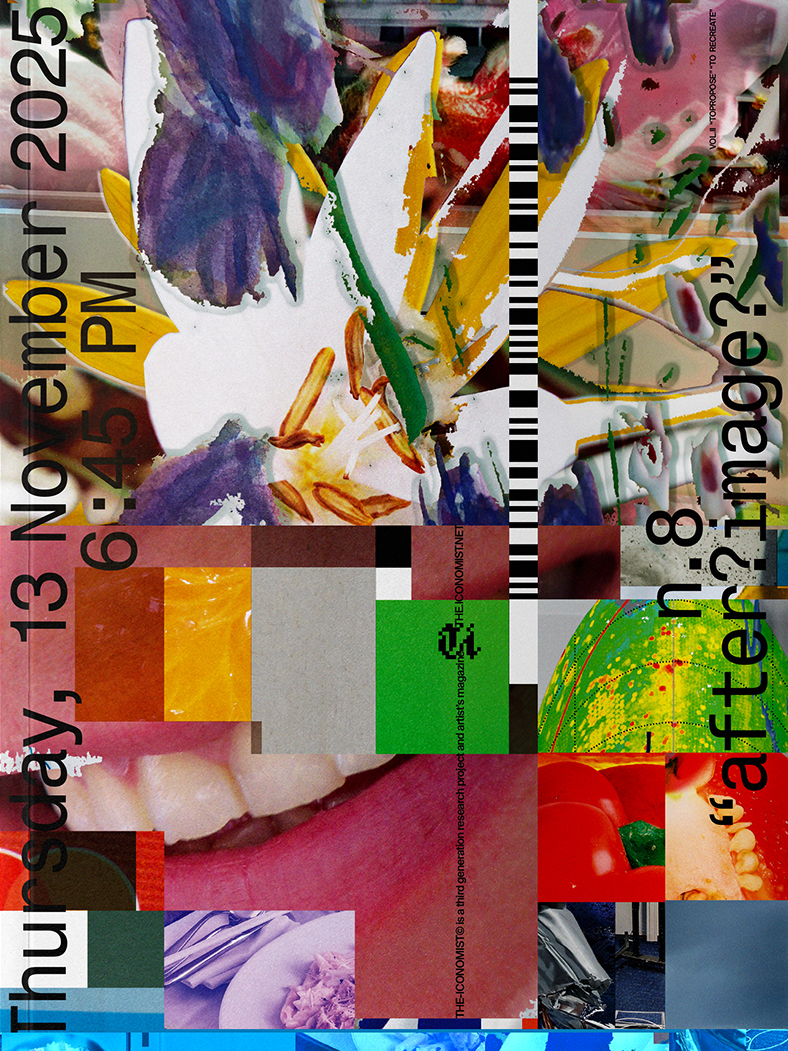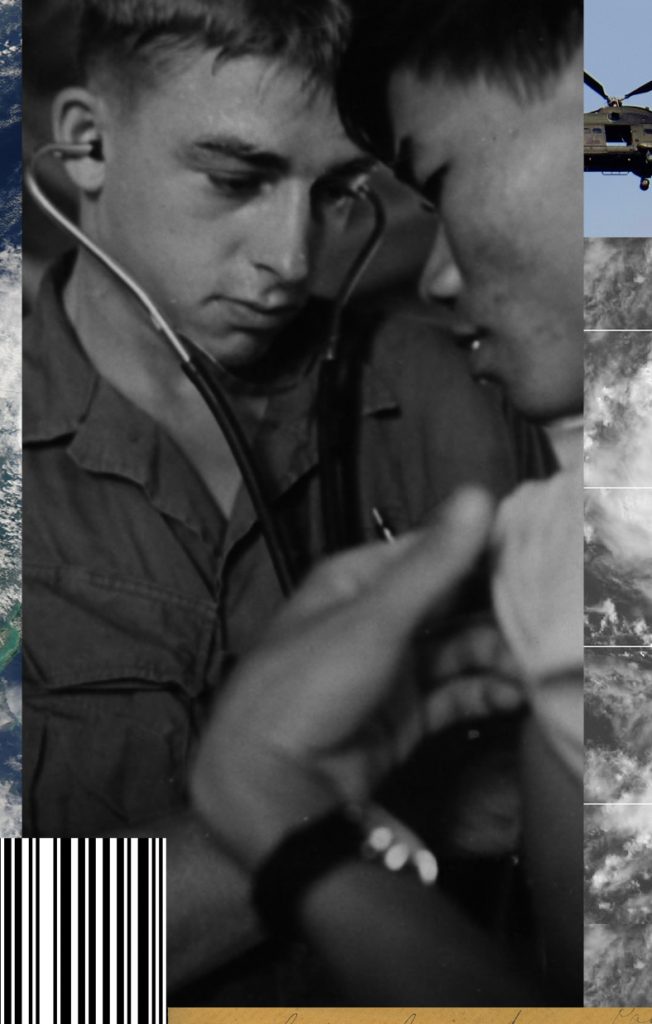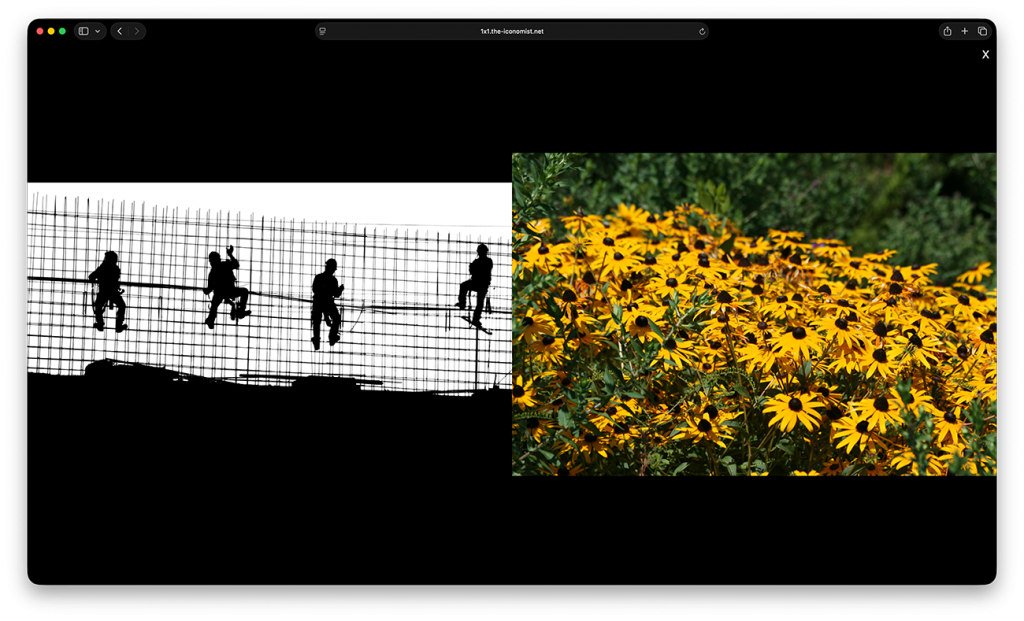/latest

Nº 8 — AFTER-IMAGE. The eighth issue of THE-ICONOMIST, titled To propose / To recreate, takes as its point of departure Édouard Glissant’s notion of the aprèzan: the present as a living interval between destruction and regeneration. From this idea unfolds a reflection on what it means to create in an era where images multiply endlessly, and where visibility itself has become a form of capture. In a world increasingly shaped by artificial intelligence, every image we share becomes data; analyzed, categorized, and reabsorbed into vast systems of recognition. Within this landscape, the publication suggests a different kind of response: a digital craftsmanship that moves against automation, exploring how the deliberate act of cutting, layering, and reassembling images can function as both creation and camouflage, a way of disrupting the smooth readability demanded by machines. To propose / To recreate unfolds as a moving terrain of visual thought, which is part proposal, part reconstruction. In addition to experimental texts created by THE-ICONOMIST, the edition also features selected excerpts from authors such as Naomi Klein, Thomas Pynchon, Mark Fisher, Olga Tokarczuk, Fernando Birri, among others.
VOL. II — IMAGE BANK (2024-present) The second volume of THE-ICONOMIST, launched in 2024, draws from Scott Watson’s idea that “we are all image banks” to explore the appropriation of digital images as a way of commenting on the world. Its editions are built from collections sourced from image banks, expanding the project’s research on contemporary visual flows and the possibilities of intervention within this vast collective repository.
/input

13TH OCTOBER_This zine is part of the 365 series, made from images related to or taken on a specific day of the year. The only restriction is that images taken or related to the current year are forbidden.
/extensions

Memoryscape, a speculative tale by THE-ICONOMIST, is a plunge into the collapse between memory and technology. A narrator drifts through feeds, notifications, algorithms, and system glitches in search of himself, but finds only echoes, noise, and screenshots of a life mediated by devices. Between buffered dreams, captcha identities, and emotions translated into data, the book unfolds a landscape where memory no longer belongs to the body but to invisible servers. Each forgotten image returns as a symptom, each notification as a shadow, each silence as a corrupted file. To escape one’s own memory becomes, then, an attempt to be reborn outside the records—an ultimate way of continuing to exist.
[145 pages, 11x18cm, brochure, with shipping worldwide]
/database
/activity
News from Switzerland: THE.ICONOMIST #issue7 and the zine F is for FRAGILITY were shortlisted for the Rosmarie Tissi Award in graphic design in the MA-g (Museum of Avant-garde) Awards. These publications will now become part of the institution’s contemporary collection.
“We always think of the imagination as the faculty that forms images. On the contrary, it deforms what we perceive; it is, above all, the faculty that frees us from immediate images and changes them. … Imagination is essentially open and elusive. We could say that a stable and completely realized image clips the wings of the imagination. It causes us to fall from the state of dreaming imagination that is not confined to image, and that we may call imageless imagination, just as we speak of imageless thought.”
— Gaston BACHELARD, in Air and Dreams (1943)
28 July 2025, 11:20 AM [PROSE] A DRESS GREW ITSELF
894 WORDS, READING TIME: 4m58s [read]
[INPUT] I TOOK A PHOTO AND I FORGOT TO FEEL.pdf
2025, research for upcoming project, 35p., 1080×1920 each [view]
/to-watch
THE WORLD AS A STAGE is based on images from public security cameras. Evoking William Shakespeare‘s famous phrase, the title suggests that everyday life is constantly under observation, turning us all into actors who play our parts in front of an invisible audience. Just as in the poem “All the World’s a Stage”, where each person plays their part in the great play of life, modern surveillance puts us on a global stage, where our every move is recorded and monitored. This film explores this dynamic, revealing how the constant presence of cameras alters our perception of privacy and behavior. This film is an extension of #issue5 of THE ICONOMIST released in July conceived as a multi-channel digital installation, in which four cameras in different locations are observed simultaneously, with the commentary coming from this control room. “The World as a Stage” also features voiceover fragments of Shakespeare’s poem, the text that opens the magazine issue and a collection of headlines from news websites forming a poem about digital everyday life. A film by THE-ICONOMIST, 11m06s, color, sound [watch]
/play

1×1 is a meeting place for images. Every moment, two appear—one on the left, one on the right—and form a momentary relationship before disappearing. Nothing repeats itself. The work moves on its own, even without the visitor’s gesture, as if it were breathing. The images cannot be saved, only seen: they remain in the time of the gaze. Between chance and repetition, 1×1 is a machine of ephemeral combinations, where the archive becomes a flow and each encounter is a possibility of meaning.
/research



At what scale should we consider the lives of Black Americans? For more than thirty years—starting while he worked as a cinematographer—Jafa has sought to answer that question, compiling notebooks with clippings from magazines, newspapers, and advertisements. Images of Mickey Mouse and Sojourner Truth intermingle with pictures of insects and astronomical phenomena; Black athletes, musicians, and artists; skulls and mutilated bodies. While each image stands alone, together they convey the shared vocabularies and collaborative practices the artist considers central to Black cultural production. Jafa’s notebooks, copies of which are presented here, testify to the complexity and beauty of Black life in the United States.
“Taking its name from economist Gilson Schwartz’s 2006 neologism ‘Iconomy’ while also nodding to longstanding news weekly The Economist, THE-ICONOMIST questions our relationship with images in this era of image saturation with each issue using verbs as its themes.”
— MAGCULTURE.com
“THE-ICONOMIST’s latest issue is hectic and “suffocating” in its use of online image banks. The magazine has never really operated within the requirements of a conventional magazine. This isn’t just because the issues don’t have any advertisements or an ISBN number, or even that it doesn’t have a website that can be indexed by Google. The magazine defies a traditional editorial approach at every turn.After its first four issues’ focus on AI-generated visuals, the magazine has returned with its fifth edition — a printed exploration of surveillance in the digital age.”
— ELLIS TREE, It’s Nice That